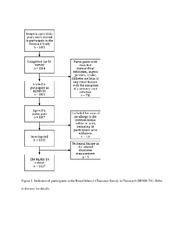| dc.contributor.advisor | Eriksen, Bjørn Odvar | |
| dc.contributor.author | Småbrekke, Silje | |
| dc.contributor.author | Schirmer, Henrik | |
| dc.contributor.author | Melsom, Toralf | |
| dc.contributor.author | Solbu, Marit Dahl | |
| dc.contributor.author | Eriksen, Bjørn Odvar | |
| dc.date.accessioned | 2020-01-27T14:51:18Z | |
| dc.date.available | 2020-01-27T14:51:18Z | |
| dc.date.issued | 2019-10-28 | |
| dc.description.abstract | Background: Although the relationship between manifest chronic kidney disease and reduced cognitive function is well established, limited data exists on GFR and cognitive function in the general population. Both the brain and kidneys have low-impedance vascular beds, rendering them susceptible to damage from pulsatile blood flow. An association between mildly reduced GFR and cognitive function in the healthy general population may reveal early disease mechanisms underlying low-grade impairment of both organs as well as the possibility for intervention. Our aim was to identify an early stage of low-grade impairments in both the brain and the kidneys in the general population.
Methods: This investigation was a population-based cross-sectional study that included 1627 participants aged 50-62 years who were representative of the general population in the municipality of Tromsø, Norway. The associations between GFR, measured as iohexol clearance, the urinary albumin-creatinine ratio and performance on five tests of cognitive function—the Digit Symbol Substitution Test, the finger tapping test, the Mini-Mental State Examination and the 12-word test parts 1 and 2 – were examined. The data were adjusted for factors known to be associated with both GFR and cognitive function, including cardiovascular risk factors, medications and education level.
Results: In multivariate adjusted linear regression analyses, we did not observe associations of the measured GFR or albumin-creatinine ratio with performance on any of the five cognitive tests. In an analysis without adjustment for the education level, an association of worse performance on the Digit Symbol Substitution Test with higher measured GFR (p = 0.03) was observed. An exploratory analysis revealed an inverse relationship between mGFR and a higher education level that remained significant after adjusting for factors known to influence mGFR.
Conclusions: We did not find evidence of an association between low-grade impairments in either the kidneys or the brain in the middle-aged general population. A possible association between a high GFR and reduced cognitive function should be investigated in future studies. | en_US |
| dc.identifier.uri | https://hdl.handle.net/10037/17234 | |
| dc.language.iso | eng | en_US |
| dc.publisher | UiT Norges arktiske universitet | en_US |
| dc.publisher | UiT The Arctic University of Norway | en_US |
| dc.rights.accessRights | openAccess | en_US |
| dc.rights.holder | Copyright 2019 The Author(s) | |
| dc.rights.uri | https://creativecommons.org/licenses/by-nc-sa/4.0 | en_US |
| dc.rights | Attribution-NonCommercial-ShareAlike 4.0 International (CC BY-NC-SA 4.0) | en_US |
| dc.subject.courseID | MED-3910 | |
| dc.subject | VDP::Medisinske Fag: 700::Klinisk medisinske fag: 750::Nefrologi, urologi: 772 | en_US |
| dc.subject | VDP::Medical disciplines: 700::Clinical medical disciplines: 750 | en_US |
| dc.title | Low-grade impairments in cognitive and kidney function in a healthy middle-aged general population: a cross-sectional study | en_US |
| dc.type | Master thesis | en_US |
| dc.type | Mastergradsoppgave | en_US |


 English
English norsk
norsk

